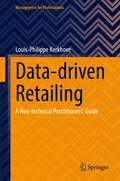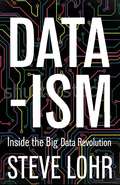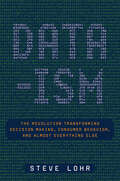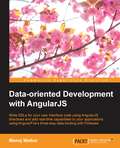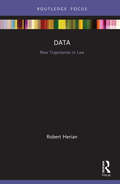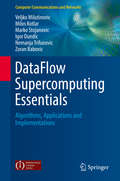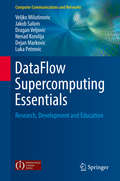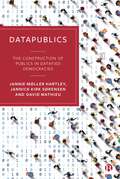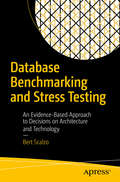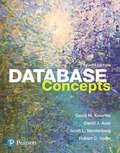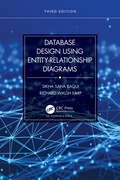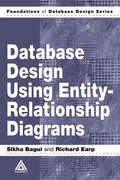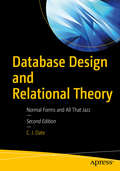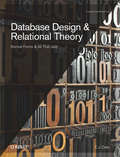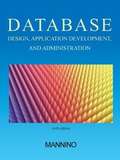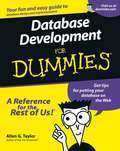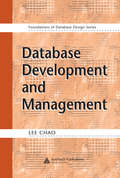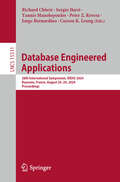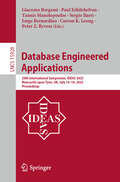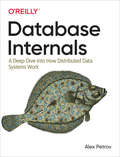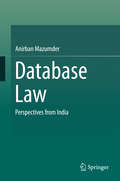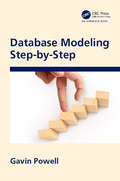- Table View
- List View
Data-driven Retailing: A Non-technical Practitioners' Guide (Management for Professionals)
by Louis-Philippe KerkhoveThis book provides retail managers with a practical guide to using data. It covers three topics that are key areas of innovation for retailers: Algorithmic Marketing, Logistics, and Pricing. Use cases from these areas are presented and discussed in a conceptual and comprehensive manner. Retail managers will learn how data analysis can be used to optimize pricing, customer loyalty and logistics without complex algorithms.The goal of the book is to help managers ask the right questions during a project, which will put them on the path to making the right decisions. It is thus aimed at practitioners who want to use advanced techniques to optimize their retail organization.
Data-ism: Inside the Big Data Revolution
by Steve LohrCoal, iron ore and oil were the fuel of the Industrial Revolution. Today's economies and governments are powered by something far less tangible: the explosive abundance of digital data.Steve Lohr, the New York Times' chief technology reporter, charts the ascent of Data-ism, the dominating philosophy of the day in which data is at the forefront of everything and decisions of all kinds are based on data analysis rather than experience and intuition. Taking us behind the scenes and introducing the DOPs (Data Oriented-People), the key personalities behind this revolution, he reveals how consuming the bits and bytes of the masses is transforming the nature of business and governance in unforeseen ways. But what are losing in the process and what new dangers await?
Data-ism: The Revolution Transforming Decision Making, Consumer Behavior, and Almost Everything Else
by Steve Lohr“Lohr uses his Pulitzer Prize-winning reporting skills to dig into and explain the power, pervasiveness, and potential downside of big data.” —Library JournalIn Data-ism, New York Times reporter Steve Lohr explains how big-data technology is ushering in a revolution in proportions that promise to be the basis of the next wave of efficiency and innovation across the economy. But more is at work here than technology. Big data is also the vehicle for a point of view, or philosophy, about how decisions will be—and perhaps should be—made in the future. Lohr investigates the benefits of data while also examining its dark side.Data-ism is about this next phase, in which vast Internet-scale data sets are used for discovery and prediction in virtually every field. It shows how this new revolution will change decision making—by relying more on data and analysis, and less on intuition and experience—and transform the nature of leadership and management. Focusing on young entrepreneurs at the forefront of data science as well as on giant companies such as IBM that are making big bets on data science for the future of their businesses, Data-ism is a field guide to what is ahead, explaining how individuals and institutions will need to exploit, protect, and manage data to stay competitive in the coming years. With rich examples of how the rise of big data is affecting everyday life, Data-ism also raises provocative questions about policy and practice that have wide implications for everyone.The age of data-ism is here. But are we ready to handle its consequences, good and bad?
Data-oriented Development with AngularJS
by Manoj WaikarThis book helps beginner-level AngularJS developers organize AngularJS applications by discussing important AngularJS concepts and best practices. If you are an experienced AngularJS developer but haven't written directives or haven't created custom HTML controls before, then this book is ideal for you.
Data: New Trajectories in Law (New Trajectories in Law)
by Robert HerianThis book explores the phenomenon of data – big and small – in the contemporary digital, informatic and legal-bureaucratic context. Challenging the way in which legal interest in data has focused on rights and privacy concerns, this book examines the contestable, multivocal and multifaceted figure of the contemporary data subject. The book analyses "data" and "personal data" as contemporary phenomena, addressing the data realms, such as stores, institutions, systems and networks, out of which they emerge. It interrogates the role of law, regulation and governance in structuring both formal and informal definitions of the data subject, and disciplining data subjects through compliance with normative standards of conduct. Focusing on the ‘personal’ in and of data, the book pursues a re-evaluation of the nature, role and place of the data subject qua legal subject in on and offline societies: one that does not begin and end with the inviolability of individual rights but returns to more fundamental legal principles suited to considerations of personhood, such as stewardship, trust, property and contract. The book’s concern with the production, use, abuse and alienation of personal data within the context of contemporary communicative capitalism will appeal to scholars and students of law, science and technology studies, and sociology; as well as those with broader political interests in this area.
DataFlow Supercomputing Essentials: Algorithms, Applications and Implementations (Computer Communications and Networks)
by Nemanja Trifunovic Veljko Milutinovic Milos Kotlar Marko Stojanovic Igor Dundic Zoran BabovicThis informative text/reference highlights the potential of DataFlow computing in research requiring high speeds, low power requirements, and high precision, while also benefiting from a reduction in the size of the equipment. The cutting-edge research and implementation case studies provided in this book will help the reader to develop their practical understanding of the advantages and unique features of this methodology. This work serves as a companion title to DataFlow Supercomputing Essentials: Algorithms, Applications and Implementations, which reviews the key algorithms in this area, and provides useful examples. Topics and features: reviews the library of tools, applications, and source code available to support DataFlow programming; discusses the enhancements to DataFlow computing yielded by small hardware changes, different compilation techniques, debugging, and optimizing tools; examines when a DataFlow architecture is best applied, and for which types of calculation; describes how converting applications to a DataFlow representation can result in an acceleration in performance, while reducing the power consumption; explains how to implement a DataFlow application on Maxeler hardware architecture, with links to a video tutorial series available online. This enlightening volume will be of great interest to all researchers investigating supercomputing in general, and DataFlow computing in particular. Advanced undergraduate and graduate students involved in courses on Data Mining, Microprocessor Systems, and VLSI Systems, will also find the book to be a helpful reference.
DataFlow Supercomputing Essentials: Research, Development and Education (Computer Communications and Networks)
by Dejan Markovic Jakob Salom Veljko Milutinovic Dragan Veljovic Nenad Korolija Luka PetrovicThis informative text/reference highlights the potential of DataFlow computing in research requiring high speeds, low power requirements, and high precision, while also benefiting from a reduction in the size of the equipment. The cutting-edge research and implementation case studies provided in this book will help the reader to develop their practical understanding of the advantages and unique features of this methodology. This work serves as a companion title to DataFlow Supercomputing Essentials: Algorithms, Applications and Implementations, which reviews the key algorithms in this area, and provides useful examples. Topics and features: reviews the library of tools, applications, and source code available to support DataFlow programming; discusses the enhancements to DataFlow computing yielded by small hardware changes, different compilation techniques, debugging, and optimizing tools; examines when a DataFlow architecture is best applied, and for which types of calculation; describes how converting applications to a DataFlow representation can result in an acceleration in performance, while reducing the power consumption; explains how to implement a DataFlow application on Maxeler hardware architecture, with links to a video tutorial series available online. This enlightening volume will be of great interest to all researchers investigating supercomputing in general, and DataFlow computing in particular. Advanced undergraduate and graduate students involved in courses on Data Mining, Microprocessor Systems, and VLSI Systems, will also find the book to be a helpful reference.
DataPublics: The Construction of Publics in Datafied Democracies
by Jannie Møller Hartley, Jannick Kirk Sørensen and David MathieuEPDF and EPUB available Open Access under CC-BY-NC-ND licence This book addresses new challenges to the formation of publics in datafied democracies. It proposes a fresh, complex and nuanced approach to understand 'datapublics' by considering datafication and public formation in the context of audience, journalism and infrastructure studies. The tightly woven chapters shed new light on how platforms, algorithms and their data infrastructure are embedded in journalistic values, discourses and practices, opening up new conditions for publics to display agency, mobilize and achieve legitimacy. This is a seminal contribution to debates about the future of media, journalism and civic practices.
Database Benchmarking and Stress Testing: An Evidence-Based Approach to Decisions on Architecture and Technology
by Bert ScalzoProvide evidence-based answers that can be measured and relied upon by your business. Database administrators will be able to make sound architectural decisions in a fast-changing landscape of virtualized servers and container-based solutions based on the empirical method presented in this book for answering “what if” questions about database performance.Today’s database administrators face numerous questions such as: What if we consolidate databases using multitenant features? What if we virtualize database servers as Docker containers? What if we deploy the latest in NVMe flash disks to speed up IO access?Do features such as compression, partitioning, and in-memory OLTP earn back their price? What if we move our databases to the cloud?As an administrator, do you know the answers or even how to test the assumptions?Database Benchmarking and Stress Testing introduces you to database benchmarking using industry-standard test suites such as the TCP series of benchmarks, which are the same benchmarks that vendors rely upon. You’ll learn to run these industry-standard benchmarks and collect results to use in answering questions about the performance impact of architectural changes, technology changes, and even down to the brand of database software. You’ll learn to measure performance and predict the specific impact of changes to your environment. You’ll know the limitations of the benchmarks and the crucial difference between benchmarking and workload capture/reply. This book teaches you how to create empirical evidence in support of business and technology decisions. It’s about not guessing when you should be measuring. Empirical testing is scientific testing that delivers measurable results. Begin with a hypothesis about the impact of a possible architecture or technology change. Then run the appropriate benchmarks to gather data and predict whether the change you’re exploring will be beneficial, and by what order of magnitude. Stop guessing. Start measuring. Let Database Benchmarking and Stress Testing show the way.What You'll LearnUnderstand the industry-standard database benchmarks, and when each is best usedPrepare for a database benchmarking effort so reliable results can be achievedPerform database benchmarking for consolidation, virtualization, and cloud projectsRecognize and avoid common mistakes in benchmarking database performanceMeasure and interpret results in a rational, concise manner for reliable comparisonsChoose and provide advice on benchmarking tools based on their pros and consWho This Book Is ForDatabase administrators and professionals responsible for advising on architectural decisions such as whether to use cloud-based services, whether to consolidate and containerize, and who must make recommendations on storage or any other technology that impacts database performance
Database Computing for Scholarly Research: Case Studies Using the Online Cultural and Historical Research Environment (Quantitative Methods in the Humanities and Social Sciences)
by Sandra R. Schloen Miller C. ProsserThis book discusses in detail a series of examples drawn from scholarly projects that use the OCHRE database platform (Online Cultural and Historical Research Environment). These case studies illustrate the wide range of data that can be managed with this platform and the wide variety of problems solved by OCHRE’s item-based graph data model. The unique features and design principles of the OCHRE platform are explained and justified, helping readers to imagine how the system could be used for their own data.Data generated by studies in the humanities and social sciences is often semi-structured, fragmented, highly variable, and subject to many interpretations, making it difficult to represent adequately in a conventional database. The authors examine commonly used methods of data management in the humanities and offer a compelling argument for a different approach that takes advantage of powerful computational techniques for organizing scholarly information.This book is a challenge to scholars in the humanities and social sciences, asking them to expect more from technology as they pursue their research goals. Written jointly by a software engineer and a research scholar, each with many years of experience in applying database methods to diverse kinds of scholarly data, it shows how scholars can make the most of their existing data while going beyond the limitations of commonly used software tools to represent their objects of study in a more accurate, nuanced, and flexible way.
Database Concepts (Eighth Edition)
by David M. Kroenke David J. Auer Scott L. Vandenberg Robert C. YoderFor undergraduate database management students or business professionals <P><P>Here’s practical help for understanding, creating, and managing small databases—from two of the world’s leading database authorities. Database Concepts gives undergraduate database management students and business professionals alike a firm understanding of the concepts behind the software, using Access 2016 to illustrate the concepts and techniques. Three projects run throughout the text, to show students how to apply the concepts to real-life business situations. The text provides flexibility for choosing the software instructors want to use in class; allows students to work with new, complete databases, including Wedgewood Pacific, Heather Sweeney Designs, and Wallingford Motors; and includes coverage for some of the latest information on databases available.
Database Design Using Entity-Relationship Diagrams
by Sikha Saha Bagui Richard Walsh EarpEssential to database design, entity-relationship (ER) diagrams are known for their usefulness in data modeling and mapping out clear database designs. They are also well-known for being difficult to master. With Database Design Using Entity-Relationship Diagrams, Third Edition, database designers, developers, and students preparing to enter the field can quickly learn the ins and outs of data modeling through ER diagramming. Building on the success of the bestselling first and second editions, this accessible text includes a new chapter on the relational model and functional dependencies. It also includes expanded chapters on Enhanced Entity-Relationship (EER) diagrams and reverse mapping. It uses cutting-edge case studies and examples to help readers master database development basics and defines ER and EER diagramming in terms of requirements (end user requests) and specifications (designer feedback to those requests), facilitating agile database development. This book Describes a step-by-step approach for producing an ER diagram and developing a relational database from it Contains exercises, examples, case studies, bibliographies, and summaries in each chapter Details the rules for mapping ER diagrams to relational databases Explains how to reverse engineer a relational database back to an entity-relationship model Includes grammar for the ER diagrams that can be presented back to the user, facilitating agile database development The updated exercises and chapter summaries provide the real-world understanding needed to develop ER and EER diagrams, map them to relational databases, and test the resulting relational database. Complete with a wealth of additional exercises and examples throughout, this edition should be a basic component of any database course. Its comprehensive nature and easy-to-navigate structure make it a resource that students and professionals will turn to throughout their careers.
Database Design Using Entity-Relationship Diagrams (Foundations of Database Design)
by Sikha BaguiEntity-relationship (E-R) diagrams are time-tested models for database development well-known for their usefulness in mapping out clear database designs. Also commonly known is how difficult it is to master them. With this comprehensive guide, database designers and developers can quickly learn all the ins and outs of E-R diagramming to become experts.
Database Design and Relational Theory: Normal Forms and All That Jazz
by C. J. DateCreate database designs that scale, meet business requirements, and inherently work toward keeping your data structured and usable in the face of changing business models and software systems.This book is about database design theory. Design theory is the scientific foundation for database design, just as the relational model is the scientific foundation for database technology in general. Databases lie at the heart of so much of what we do in the computing world that negative impacts of poor design can be extraordinarily widespread. This second edition includes greatly expanded coverage of exotic and little understood normal forms such as: essential tuple normal form (ETNF), redundancy free normal form (RFNF), superkey normal form (SKNF), sixth normal form (6NF), and domain key normal form (DKNF). Also included are new appendixes, including one that provides an in-depth look into the crucial notion of data consistency. Sequencing of topics has been improved, and many explanations and examples have been rewritten and clarified based upon the author’s teaching of the content in instructor-led courses. This book aims to be different from other books on design by bridging the gap between the theory of design and the practice of design. The book explains theory in a way that practitioners should be able to understand, and it explains why that theory is of considerable practical importance. Reading this book provides you with an important theoretical grounding on which to do the practical work of database design. Reading the book also helps you in going to and understanding the more academic texts as you build your base of knowledge and expertise. Anyone with a professional interest in database design can benefit from using this book as a stepping-stone toward a more rigorous design approach and more lasting database models.What You Will LearnUnderstand what design theory is and is notBe aware of the two different goals of normalizationKnow which normal forms are truly significant Apply design theory in practice Be familiar with techniques for dealing with redundancy Understand what consistency is and why it is crucially important Who This Book Is ForThose having a professional interest in database design, including data and database administrators; educators and students specializing in database matters; information modelers and database designers; DBMS designers, implementers, and other database vendor personnel; and database consultants. The book is product independent.
Database Design and Relational Theory: Normal Forms and All That Jazz
by C. J. DateWhat makes this book different from others on database design? Many resources on design practice do little to explain the underlying theory, and books on design theory are aimed primarily at theoreticians. In this book, renowned expert Chris Date bridges the gap by introducing design theory in ways practitioners can understand—drawing on lessons learned over four decades of experience to demonstrate why proper database design is so critical in the first place.Every chapter includes a set of exercises that show how to apply the theoretical ideas in practice, provide additional information, or ask you to prove some simple theoretical result. If you’re a database professional familiar with the relational model, and have more than a passing interest in database design, this book is for you.Questions this book answers include:Why is Heath’s Theorem so important?What is The Principle of Orthogonal Design?What makes some JDs reducible and others irreducible?Why does dependency preservation matter?Should data redundancy always be avoided? Can it be?Databases often stay in production for decades, and careful design is critical for avoiding subtle errors and processing problems over time. If they’re badly designed, the negative impacts can be incredibly widespread. This gentle introduction shows you how to use important theoretical results to create good database designs.
Database Design, Application Development, and Administration (Fifth Edition)
by Mannino Michael V. ManninoThis course has two teaching challenges - good database design and a skills-development approach. This text contains worked examples along with projects that need manipulation of sample databases. Entity relationship diagrams are also included, as well as a software design tool, ER-Assistant.
Database Design, Application Development, and Administration (Sixth Edition)
by Michael ManninoMannino provides with a foundation to understand database technology supporting enterprise computing needs. The text is ideal for new students of database management, who need to understand the fundamental concepts of database management and the relational data model, followed by a mastery of skills in database design and database application development. This textbook provides tools to help students understand relational databases and acquire skills to solve basic and advanced problems in query formulation, data modeling, normalization, application data requirements, and customization of database applications.
Database Development For Dummies (For Dummies Ser.)
by Allen G. TaylorFrom ATMs to the personal finance, online shopping to networked information management, databases permeate every nook and cranny of our highly-connected, information-intensive world. Databases have become so integral to the business environment that, nowadays, it’s next to impossible to stay competitive without the assistance of some sort of database technology—no matter what type or size of business you run. But developing your own database can be very tricky. In fact, whether you want to keep records for a small business or run a large e-commerce website, developing the right database system can be a major challenge. Which is where this friendly guide comes in. From data modeling methods and development tools to Internet accessibility and security, Database Development For Dummies shows you, step-by-step, everything you need to know about building a custom system from the ground up. You’ll discover how to: Model data accurately Design a reliable functional database Deliver robust relational databases on time and on budget Build a user-friendly database application Put your database on the Web In plain English, author Allen Taylor acquaints you with the most popular data modeling methods, and he shows you how to systematically design and develop a system incorporating a database and one or more applications that operate on it. Important topics he explores include: Understanding database architecture and how it has evolved Recognizing how database technology affects everyday life Using a structured approach to database development Creating an appropriate data model Developing a reliable relational design Understanding the complexities you’re likely to encounter in designing a database and how to simplify them Implementing your design using Microsoft Access 2000, SQL Server and other powerful database development tools Keeping your database secure Putting your database on the Internet Today’s powerful, low-cost database development tools make it possible for virtually anybody to create their own database. Get Database Development For Dummies and discover what it takes to design, develop and implement a sophisticated database system tailored to you and your company’s current and future data storage and management needs.
Database Development and Management (Foundations of Database Design)
by Lee ChaoToday's database professionals must understand how to apply database systems to business processes and how to develop database systems for both business intelligence and Web-based applications.Database Development and Management explains all aspects of database design, access, implementation, application development, and management, as well
Database Engineered Applications: 28th International Symposium, IDEAS 2024, Bayonne, France, August 26–29, 2024, Proceedings (Lecture Notes in Computer Science #15511)
by Richard Chbeir Yannis Manolopoulos Jorge Bernardino Peter Z. Revesz Carson K. Leung Sergio IlarriThis LNCS conference volume constitutes the proceedings of 28th International Symposium on Database Engineered Applications, IDEAS 2024, in Bayonne, France, in August 2024. The 21 full papers together with 5 short papers included in this volume were carefully reviewed and selected from 34 submissions. The symposium presents papers in the broader field of data management and were organized in seven sessions: (1) Theoretical Issues; (2) Classification; (3) Text and Languages; (4) Big Data; (5) Query Processing and Applications; (6) Machine Learning and Rules; (7) Recommendation, and (8) Indexing and Event Detection
Database Engineered Applications: 29th International Symposium, IDEAS 2025, Newcastle upon Tyne, UK, July 14–16, 2025, Proceedings (Lecture Notes in Computer Science #15928)
by Yannis Manolopoulos Jorge Bernardino Peter Z. Revesz Carson K. Leung Sergio Ilarri Paul Ezhilchelvan Giacomo BergamiThis LNCS conference volume constitutes the proceedings of 29th International Symposium on Database Engineered Applications, IDEAS 2025, in Newcastle upon Tyne, UK, in July 2025. The 13 full papers and 6 short papers included in this book were carefully reviewed and selected from 30 submissions. They were organized in topical sections as follows: language and models; classification; distributed systems; query answering and education; and data mining.
Database Internals: A Deep Dive into How Distributed Data Systems Work
by Alex PetrovWhen it comes to choosing, using, and maintaining a database, understanding its internals is essential. But with so many distributed databases and tools available today, it’s often difficult to understand what each one offers and how they differ. With this practical guide, Alex Petrov guides developers through the concepts behind modern database and storage engine internals.Throughout the book, you’ll explore relevant material gleaned from numerous books, papers, blog posts, and the source code of several open source databases. These resources are listed at the end of parts one and two. You’ll discover that the most significant distinctions among many modern databases reside in subsystems that determine how storage is organized and how data is distributed.This book examines:Storage engines: Explore storage classification and taxonomy, and dive into B-Tree-based and immutable Log Structured storage engines, with differences and use-cases for eachStorage building blocks: Learn how database files are organized to build efficient storage, using auxiliary data structures such as Page Cache, Buffer Pool and Write-Ahead LogDistributed systems: Learn step-by-step how nodes and processes connect and build complex communication patternsDatabase clusters: Which consistency models are commonly used by modern databases and how distributed storage systems achieve consistency
Database Law: Perspectives from India
by Anirban MazumderThis book focuses on database law (a branch of intellectual property law) and further explores the legal protection currently available for data and data-related products in India. It offers a comparative study of the position of copyright law in protecting databases in the US and EU, while also presenting responses from the Indian database industry and its aspirations regarding the role of copyright law in database protection. India is undoubtedly leading the way as a knowledge economy. Its strengths are its information technology capability and its knowledge society, as well as its booming database industry aspects that also necessitate the study of the role of law, as well as the protection of data and databases, in India. This book examines the growing importance of copyright law for protecting databases as well as for ensuring access in information societies. The book concludes with a discussion of key principles to be kept in mind in the context of drafting legal regimes for databases in India that will both benefit the database industry and ensure accessibility. "
Database Management System: An Evolutionary Approach
by Ravi Tomar Jagdish Chandra Patni Hitesh Kumar Sharma Avita KatalA database management system (DBMS) is a collection of programs that enable users to create and maintain a database; it also consists of a collection of interrelated data and a set of programs to access that data. Hence, a DBMS is a general-purpose software system that facilitates the processes of defining, constructing, and manipulating databases for various applications. The primary goal of a DBMS is to provide an environment that is both convenient and efficient to use in retrieving and storing database information. It is an interface between the user of application programs, on the one hand, and the database, on the other. The objective of Database Management System: An Evolutionary Approach, is to enable the learner to grasp a basic understanding of a DBMS, its need, and its terminologies discern the difference between the traditional file-based systems and a DBMS code while learning to grasp theory in a practical way study provided examples and case studies for better comprehension This book is intended to give under- and postgraduate students a fundamental background in DBMSs. The book follows an evolutionary learning approach that emphasizes the basic concepts and builds a strong foundation to learn more advanced topics including normalizations, normal forms, PL/SQL, transactions, concurrency control, etc. This book also gives detailed knowledge with a focus on entity-relationship (ER) diagrams and their reductions into tables, with sufficient SQL codes for a more practical understanding.
Database Modeling Step by Step
by Gavin PowellWith the aim of simplifying relational database modeling, Database Modeling Step-by-Step presents the standard approach to database normalization and then adds its own approach, which is a more simplistic, intuitive way to building relational database models. Going from basics to contemporary topics, the book opens with relational data modeling and ends with BigData database modeling following a road map of the evolution in relational modeling and including brief introductions to data warehousing and BigData modeling. A break-down of the elements of a model explains what makes up a relational data model. This is followed by a comparison between standard normalization and a more simplistic intuitive approach to data modeling that a beginner can follow and understand. A brief chapter explains how to use the database programming language SQL (Structured Query Language), which reads from and writes to a relational database. SQL is fundamental to data modeling because it helps in understanding how the model is used. In addition to the relational model, the last three chapters cover important modern world topics including denormalization that leads into data warehouses and BigData database modeling. The book explains how there is not much to logical data modeling in BigData databases because as they are often schema-less, which means that BigData databases do not have schemas embedded into the database itself, they have no metadata and thus not much of a logical data model. Online bonus chapters include a case study that covers relational data modeling and are available at the author’s web site: www.oracletroubleshooter.com/datamodeling.html
